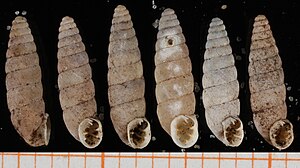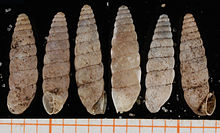Abida attenuata
| Abida attenuata | ||||||||||||
|---|---|---|---|---|---|---|---|---|---|---|---|---|

Abida attenuata |
||||||||||||
| Systematics | ||||||||||||
|
||||||||||||
| Scientific name | ||||||||||||
| Abida attenuata | ||||||||||||
| ( Fagot , 1886) |
Abida attenuata is a species of grain snails (Chondrinidae) from the suborder of land snails (Stylommatophora).
features
The slim conical to slim cylindrical-spindle-shaped housing is 6.5 to 9.0 mm and 2.0 to 2.4 mm high. It has 8.5 to 11 moderately arched turns that increase moderately quickly. After about 7 turns, the maximum thickness (width) is reached: after that, it does not increase or only increases slightly in thickness. The surface is regularly and finely striped. The comparatively small, rounded mouth has a strongly thickened, threshold-shaped whitish inner lip. The mouth edges are connected to one another like a strip in the parietal area and are slightly pulled forward. The mouth reinforcement consists of a maximum of angularis, subangularis, spiralis, parietalis, infraparietalis, columellaris, infracolumellaris, four palatal teeth, a suprapalatalis and a suturalis. The angularis is usually fused with the spiral. The subangularis is oblique to the angularis and forms the extension of the parietal ridge of the mouth rim. In addition to the tooth-like parietalis, an infraparietalis can also be present. The columellaris is significantly higher than the infracolumellaris and extends further forward at the spindle edge. The infrapalatalis, the inferior palatalis and the superior palatalis are shaped as double humps and extend forward to the edge of the mouth. In the inferior palatalis, the two cusps are occasionally almost fused together. There is also a suprapalatalis and occasionally a weak suturalis. In addition, individual edge wrinkles can occur. The last turn of the case is not narrowed, but there is a distinct keel at the base. Occasionally, there is also a weak neck bulge. At the point of the infrapalatalis, the housing is heavily indented and also often notched. In the side view, the mouth edge bends slightly backwards after about a third (from above). The navel is relatively wide and open when viewed from above.
In the male part of the reproductive system, the penis is significantly longer than the epiphallus . The epiphallus is fused with the penis in the lower part of the penis and forms a loop with the penis. The "free" penis (i.e., the part of the penis below the adhesions) takes up about a quarter to a third of the length of the loop. The penis / epiphallus transition is a little below the bending point; it is marked by a significant reduction in the lumen and a change in the internal structure. The penile retractor muscle attaches to the first quarter or fifth of the loop. The spermatic duct is not twisted and is fused with the penile tissue in the lower part. The vagina and free fallopian tubes are approximately the same length. The seminal vesicle is only elongated and hardly enlarged; the stem is very long. The seminal vesicle is not embedded in the tissue of the prostate gland and its length reaches the albumin gland. The stem of the seminal vesicle is at the branch of free fallopian tubes / stem of the seminal vesicle more than twice as thick as the free fallopian tube. The radula shows 17 to 18 posterior teeth in the semi-transverse row next to the central tooth.
Similar species
Abida attenuata differs from all other Abida species by its small mouth and the position or formation of the subangularis .
Geographical distribution and habitat
The range of the species is disjoint , i.e. that is, it occurs in two non-contiguous areas. The southern distribution area is in Spain in the area of Orduña ( province of Bizkaia ). The second area extends as a narrow strip in southern France from Quéribus Castle ( Aude department ) in the east to Usson-les-Bains ( Rouze municipality , Ariège department ) in the west. The species occurs there from about 150 m to 900 m above sea level.
Taxonomy
The taxon was first described by Paul Fagot in 1886 as Pupa attenuata . Edmund Gittenberger mentions the synonym : Pupa leptospira Westerlund, 1886. The species is accepted as a valid taxon by Fauna Europaea.
According to molecular biology results, Abida attenuata hybridized with Abida secale in southern France . In the area where the two species coexist, the genome of Abida secale shows characteristics of the genome of Abida attenuata .
Danger
According to the assessment of the International Union for Conservation of Nature and Natural Resources (IUCN), the species is not endangered despite its small distribution area.
supporting documents
literature
- Edmund Gittenberger: Contributions to the knowledge of the pupillacea: III. Chondrininae. Zoologische Verhandelingen, 127 (1): 3-267, 1973 ISSN 0024-1652 PDF (pp. 128-132).
- Bas Kokshoorn, Edmund Gittenberger: Chondrinidae taxonomy revisited: New synonymies, new taxa, and a checklist of species and subspecies (Mollusca: Gastropoda: Pulmonata). Zootaxa, 2539: 1–62, 2010 Preview (PDF; 22 kB)
- Francisco W. Welter-Schultes: European non-marine molluscs, a guide for species identification = identification book for European land and freshwater mollusks. A1-A3 S., 679 S., Q1-Q78 S., Göttingen, Planet Poster Ed., 2012 ISBN 3-933922-75-5 , ISBN 978-3-933922-75-5
Individual evidence
- ^ Paul Fagot: Promenades malacologiques dans le sud de la France. Bulletins de la Société Malacologique de France, 3: 165-224, Paris 1886 Online at www.biodiversitylibrary.org .
- ↑ Fauna Europaea: Abida attenuata (Fagot 1886)
- ↑ Gargominy, O. 2011. Abida attenuata . In: IUCN 2013. IUCN Red List of Threatened Species. Version 2013.1. <www.iucnredlist.org>. Retrieved September 22, 2013.
